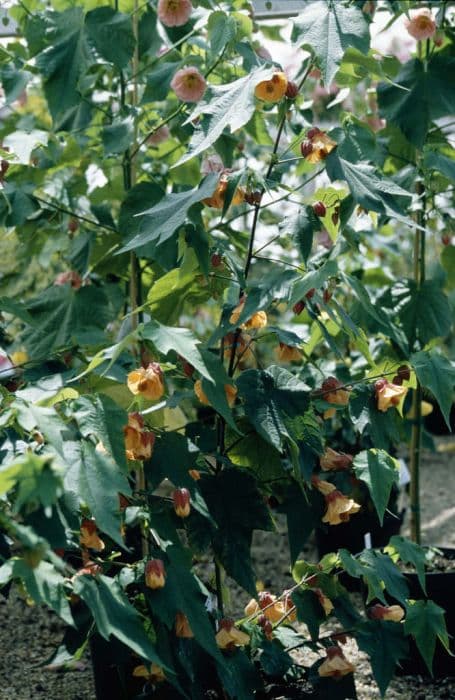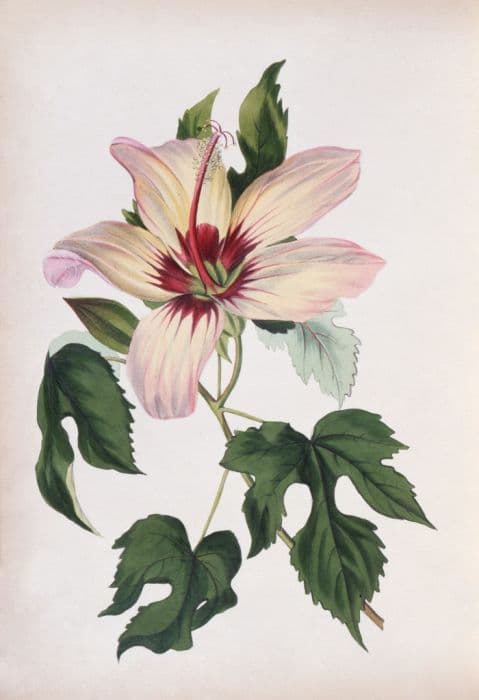Lavender Star Flower Grewia occidentalis

ABOUT
The plant commonly known as lavender star flower is a visually appealing shrub that is cherished for its ornamental qualities. It has a lush, bushy growth habit, giving it a dense and rounded appearance. The leaves are fresh green, with a slightly glossy texture and an ovate shape, often sporting subtle toothed edges that contribute to their charm. The most striking feature of the lavender star flower is its blossoms. These delicate flowers, true to its name, resemble stars with their five-petaled display. The petals themselves are a beautiful shade of lavender or pale violet, which can add a soft, colorful accent to gardens. The flowers are also noteworthy for their prominent, yellowish-white centers which contrast with the lavender petals. Additionally, this plant may produce small, round, and fleshy fruits that turn from green to deep purple as they mature. It is worth noting, however, that while beautiful, the size specifications are not included in this description.
About this plant
 Names
NamesFamily
Malvaceae.
Synonyms
Crossberry, Lavender Star Flower, Lavender Star, Star Flower.
Common names
Grewia caffra, Grewia occidentalis var. calva, Grewia occidentalis var. occidentalis, Grewia occidentalis var. villosa.
 Toxicity
ToxicityTo humans
The plant commonly known as Lavender Star Flower (Grewia occidentalis) is not widely regarded as toxic to humans. There is limited information suggesting toxicity; however, as with any plant, individuals may experience allergic reactions or irritation when handling or ingesting plants that they are not familiar with. It's always recommended to exercise caution and keep plants away from small children who might ingest them out of curiosity.
To pets
Lavender Star Flower (Grewia occidentalis) is not known to be toxic to pets. There are no widespread reports of significant toxicity in domestic animals such as dogs and cats. Nonetheless, pet owners should always monitor their pets around plants and be cautious as individual animals may have different sensitivities or allergies. If a pet shows signs of distress after ingesting any plant material, contacting a veterinarian is advisable.
 Characteristics
CharacteristicsLife cycle
Perennials
Foliage type
Evergreen
Color of leaves
Green
Flower color
Pink
Height
6-8 feet (1.82-2.43 meters)
Spread
6-8 feet (1.82-2.43 meters)
Plant type
Shrub
Hardiness zones
9
Native area
Africa
Benefits
 General Benefits
General Benefits- Attractive Ornamental: The Crossberry, with its lush foliage and pink to mauve star-shaped flowers, adds aesthetic value to landscapes.
- Wildlife Habitat: It serves as a habitat and food source for birds, insects, and other wildlife, its berries in particular being a favorite among birds.
- Drought Resistance: Being native to Southern Africa, the Crossberry is well-suited to dry climates and can tolerate periods of drought.
- Shade Provider: With its bushy growth habit, the Crossberry offers natural shade in gardens and outdoor spaces.
- Edible Fruit: The Crossberry's fruit is edible, often enjoyed by local communities, and can be used to make traditional drinks or jellies.
- Erosion Control: Its root system helps stabilize the soil, making it a good choice for erosion control on slopes or banks.
- Cultural Significance: In its native habitat, the Crossberry is often used in traditional ceremonies or practices, adding cultural value to the region.
- Suitable for Hedging: The Crossberry can be pruned to form dense hedges or screens, providing privacy and wind protection.
 Medical Properties
Medical Properties- Anti-inflammatory: Grewia occidentalis has been traditionally used to reduce inflammation.
- Antioxidant: The plant may contain antioxidant chemicals that help in protecting the body from oxidative stress.
- Diuretic: In some traditional medicine systems, the plant is believed to promote the production of urine, aiding in detoxification and renal function.
- Antimicrobial: Some studies suggest that extracts from Grewia occidentalis might have antimicrobial properties against certain pathogens.
- Antipyretic: It has been used to reduce fever in traditional medicine practices.
- Analgesic: The plant has been used to alleviate pain, similarly to how other analgesic agents work.
 Air-purifying Qualities
Air-purifying QualitiesThis plant is not specifically known for air purifying qualities.
 Other Uses
Other Uses- Grewia occidentalis, commonly known as Lavender Star Flower, can be used as a natural dye source, with various plant parts yielding shades of hues for textiles.
- The flexible stems of the Lavender Star Flower can be woven into baskets and other forms of traditional craftwork.
- The Lavender Star Flower's nectar-rich blossoms attract pollinators, thus it can be planted to enhance pollination in gardens and agricultural areas.
- Its dense foliage provides shelter and habitat for small birds and insects within an ecosystem, promoting biodiversity.
- When pruned and managed, the Lavender Star Flower can also serve as a living fence or hedge, offering privacy and wind protection.
- The wood of the Lavender Star Flower is sometimes utilized for making small, handcrafted wooden tools or items.
- The fruit of the Lavender Star Flower can be used to create a fermented beverage or used as a flavoring agent in various foods.
- The flowering plant can be used in sensory gardens due to its aromatic leaves and pleasantly scented flowers which provide olfactory stimulation.
- It can provide a natural source of biomass which, through decomposition, improves soil structure and fertility over time.
- Mainly used for ornamental purposes, the Lavender Star Flower can be trained into a bonsai, making it an indoor artistic exhibition piece.
Interesting Facts
 Feng Shui
Feng ShuiThe Crossberry is not used in Feng Shui practice.
 Zodiac Sign Compitability
Zodiac Sign CompitabilityThe Crossberry is not used in astrology practice.
 Plant Symbolism
Plant Symbolism- Resilience: The Grewia occidentalis, commonly known as Lavender Star Flower, can withstand a variety of growing conditions, which symbolizes an ability to persevere and thrive in different environments.
- Growth and Vitality: As a plant that blooms with star-shaped flowers, it represents growth and the vitality necessary to push through life's challenges.
- Connection and Crossing Paths: With its interlacing branches, the Lavender Star Flower symbolizes the interconnectedness of life and how our paths may cross with others.
- Protection: In some cultures, the dense foliage and the intricate system of the plant's branches are considered symbols of shelter and protection against negative influences.
- Beauty and Radiance: The bright, attractive flowers of the Lavender Star Flower symbolize natural beauty and the radiance that one brings to the lives of others.
 Water
WaterThe Lavender Star Flower should be watered regularly, aiming for at least once a week when the top inch of soil has dried out. During active growing seasons, spring and summer, it may require more frequent watering, potentially twice a week depending on the temperature and humidity. Each watering should be thorough, allowing water to reach deep into the root system, using approximately half a gallon of water for a medium-sized outdoor shrub. In the cooler fall and winter months, watering should be reduced to once every two weeks, as the plant goes into a more dormant state.
 Light
LightThe Lavender Star Flower thrives best in full sunlight to partial shade. A spot that offers direct sunlight for at least six hours a day is ideal, but it can also perform well with light dappled shade, especially during the hottest part of the day. Avoid placing it in deep shade as this can impede flowering and overall vigor.
 Temperature
TemperatureThe Lavender Star Flower prefers moderate to warm temperatures and can tolerate a range from about 20 to 100 degrees Fahrenheit. Their ideal temperature range for thriving lies between 60 to 85 degrees Fahrenheit. At temperatures below 20 degrees, the plant may suffer from frost damage and could require protection or moving to a warmer location if potted indoors.
 Pruning
PruningPruning the Lavender Star Flower promotes a more dense and compact growth habit and encourages more prolific blooming. Prune in late winter to early spring before new growth begins, removing any dead or damaged branches and shaping the plant as desired. Annually trimming about a third of the oldest stems can rejuvenate the plant. Pruning just after the bloom cycle can also help tidy the plant and prepare it for the next wave of flowers.
 Cleaning
CleaningAs needed
 Soil
SoilFor the Lavender Star Flower, a well-draining soil mix is essential, incorporating ingredients such as loam, peat, and perlite or sand to ensure good aeration and drainage. The ideal pH for this soil should be between 5.5 and 6.5. Regular potting soil amended with some grit can also work well.
 Repotting
RepottingLavender Star Flower should be repotted every 2 to 3 years or when it has outgrown its current container. Younger plants may require more frequent repotting while mature plants can be repotted less often.
 Humidity & Misting
Humidity & MistingLavender Star Flower prefers moderate to high humidity levels. Aim for humidity levels around 40-50% for optimal growth conditions for this plant.
 Suitable locations
Suitable locationsIndoor
Place Lavender Star Flower in bright, indirect light indoors.
Outdoor
Plant in light shade to full sun and shelter from strong winds.
Hardiness zone
9-11 USDA
 Life cycle
Life cycleGrewia occidentalis, commonly known as the Lavender Star Flower, begins its life cycle as a seed, which requires well-drained soil and warm temperatures to germinate, usually in spring. Upon germination, the seedling grows rapidly, producing distinctive lobed leaves and continuing its growth to form a woody shrub or small tree. The plant reaches maturity in a few years, during which it develops star-shaped lavender flowers that bloom profusely in the warmer months, attracting pollinators such as bees and birds. Following pollination, the flowers develop into small, fleshy, purple to reddish fruit, which mature and may be dispersed by animals, aiding in seed spread. The Lavender Star Flower can live for many years, continuously producing flowers and fruit each season if the conditions are favorable. With time, the plant may become woody and less vigorous, eventually dying back, completing the life cycle, and leaving seeds which may give rise to new plants.
 Propogation
PropogationPropogation time
Spring to Summer
Grewia occidentalis, commonly known as the lavender star flower, is often propagated via semi-hardwood cuttings. This method is typically performed during the summer when the plant's growth is most active. Cuttings should be 4 to 6 inches long and taken from the current year's growth. The lower leaves are removed, and the base of the cutting is dipped in a rooting hormone to enhance root development. Then, the prepared cuttings are placed in a well-draining soil mix and kept moist but not overly wet. Indirect sunlight is ideal for rooting, which generally takes several weeks. During this time, ensuring a high humidity environment can be beneficial for root development, often achieved by placing a plastic bag over the cuttings to act as a mini greenhouse.









